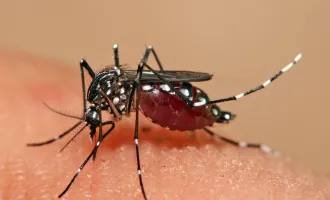This Date in UCSF History: Ether Causes Explosion
Originally published in Synapse - The UCSF student newspaper March 30, 1995.
The explosion that occurred March 9 in Pharmaceutical Chemistry Professor Martin Shetlar’s laboratory on the 10th floor of the Medical Sciences building was a powerful reminder to all of us who work in or near a laboratory of the respect that must be given to certain chemicals commonly used in routine biological experiments.
The windows were shattered, the building evacuated for several hours, and Parnassus Ave. was blocked off by fire engines, creating quite a stir amongst the lunchtime crowd across the street.
Thankfully, Shetlar was not seriously injured and things around his laboratory have since returned to normal; but there is a lesson to be learned from the experience.
The explosion was caused by a reaction of the chemical diethyl ether.
The normally unreactive nature of ether makes it a useful solvent for many reactions, and this is mainly what it is used for in the lab, especially in the process of protein synthesis.
The physical properties of diethyl ether can be understood by an examination of its chemical structure. It consists of an oxygen molecule connected on either side to two two-carbon chains and their associated hydrogens, hence diethyl.
The fairly spread out structure of the compound makes for weak attractive forces between the molecules, giving this ether a very low boiling point, 34.5 degrees Celsius, only about 10 degrees above normal room temperature.
As one introductory organic chemistry text explains it, “One of the most important reactions of ethers is an undesirable one — the reaction with atmospheric oxygen to form peroxides (autoxidation).”
The reaction is a free radical mechanism which involves the incorporation of two additional oxygen atoms from the air, linking two ether molecules with an oxygen-oxygen bond.
The resulting compound is called a hydroperoxide. Peroxides are notoriously unstable because the 0-0 bond is weak and readily broken at relatively low temperatures.
The autoxidation reaction is so prevalent that any ethers that have been stored for some period of time invariably contain peroxides.
Peroxides are very dangerous because they decompose violently at moderate temperatures, activated by a slightly elevated temperature, the friction of moving it, or an impact. This decomposition may result in an explosion.
Ether is very volatile, meaning that is will evaporate quickly when exposed to air. The peroxides which develop within the ether, however, are not volatile and remain in the diminishing liquid level as the ether evaporates over time, creating a concentrated substance that may explode fairly easily, and with great force.
On March 9, Shetlar recalls, he was participating in a routine lab clean-up, emptying out the storage cabinets of old chemicals, to be disposed of as chemical waste.
He came across two cans of ether in the back of a cabinet; the cans, as far as he knew, had been there since 1985.
Well aware of the dangers of old ether, Shetlar carefully set the cans in the fume hood next to the cabinet, venting the lids. He went back to work in the cabinet and almost immediately heard a “pop” sound from the hood.
When he turned to see what had caused the sound, the explosion occurred and he was knocked down.
That is all he can remember, he told Synapse in an interview March 28.
Several students were in another part of the laboratory — Rob Cerpa, Dallas Connor, and Yoko Haga — and they immediately rushed over,
pulling Shedar under the shower and extinguishing a fire that had started in the hood. Roger Cook, professor of Biochemistry, came running in with another fire extinguisher to complete putting out the fire.
“Shetlar considers these people heroes,” says the dean of the School of Pharmacy, George Kenyon.
Shetlar was not severely injured; he did not lose consciousness and he walked to the Moffitt emergency room. He suffered some cuts from flying glass and some burns from a bottle of nitric acid which exploded.
The glasses he was wearing were made of safety glass and “almost certainly saved his vision,” according to Kenyon.
Shetlar’s hearing was not affected, presumably because the pressure build-up was the same on both sides of his head. The pressure inside the lab from the ether explosion was, however, much greater than that outside, and in all, 12 windows were blown out.
The windows breaking was preferable to what might have happened had they not been there; Kenyon and others tell stories of (larger scale) ether explosions in windowless rooms in which the walls were forced outward up to 18 inches.
The School of Pharmacy Safety Committee and the Environmental Health and Safety (EH&S) office are investigating what happened, and although no one will be completely sure about the course of events, a theory is beginning to emerge.
Apparently, a steam valve was leaking in the hood where the old cans of ether were placed. Representatives from EH&S have informed Shetlar that there were bottles of ether in the adjacent hood, and these were the ones in which the fire started.
Shetlar figures that the fumes from the vented old cans of ether may have ignited when exposed to the higher temperatures of the leaking steam vent.
This flame probably ignited the bottles of ether in the next hood, and this ether fire triggered the explosion in the old cans.
Vladimir Basus, who is investigating the incident for the School of Pharmacy, emphasizes that it is not clear that the explosion was a result of peroxides, although it could be.
Some of the ether bottles in the adjacent hood were not even tipped over, so it is unlikely that they exploded. Basus thinks one possibility is that the fire that was created blew the lids from the cans, and ejected ether into the air.
This ether came into contact with the higher temperatures in the hood due to the fire and caused the major explosion. In any event, there was also a bottle of nitric acid (awaiting transport to chemical waste) in the first hood, next to the cabinet in which Shetlar was working. This bottle exploded, spraying acid in that immediate vicinity and burning his face and hair.
Luckily, no one but Shetlar was injured — and he was able to return to work within a few days.
The windows were replaced by the next day, and except for the area directly surrounding the fume hood, there was no damage to the laboratory (except for the posterof Japanese postcards that was sprayed with acid). Kenyon was very pleased with the cooperation of the rest of Medical Sciences building personnel in evacuating calmly and quickly.
“EH&S and the campus police handled the situation very well,” he adds.
Luckily, no one but Shetlar was injured — and he was able to return to work within a few days.
The windows were replaced by the next day, and except for the area directly surrounding the fume hood, there was no damage to the laboratory (except for the poster of Japanese postcards that was sprayed with acid).
Kenyon was very pleased with the cooperation of the rest of Medical Sciences building personnel in evacuating calmly and quickly.
“EH&S and the campus police handled the situation very well,” he adds.
Although ether is almost ubiquitous in biological research laboratories, and most workers are aware that it is flammable and should be kept away from open flames, ether’s tendency to form explosive compounds upon contact with air is not as well known.
The laboratory safety manual published by the American Society for Microbiology advises that ethers should not be stored for more than three months and chemicals suspected of being explosive due to age or neglect should be turned over to experts at dealing with such compounds (our EH&S).
To date, EH&S has received 104 bottles of ether since the explosion occurred.



